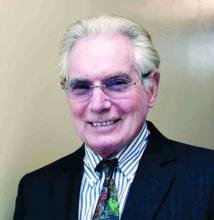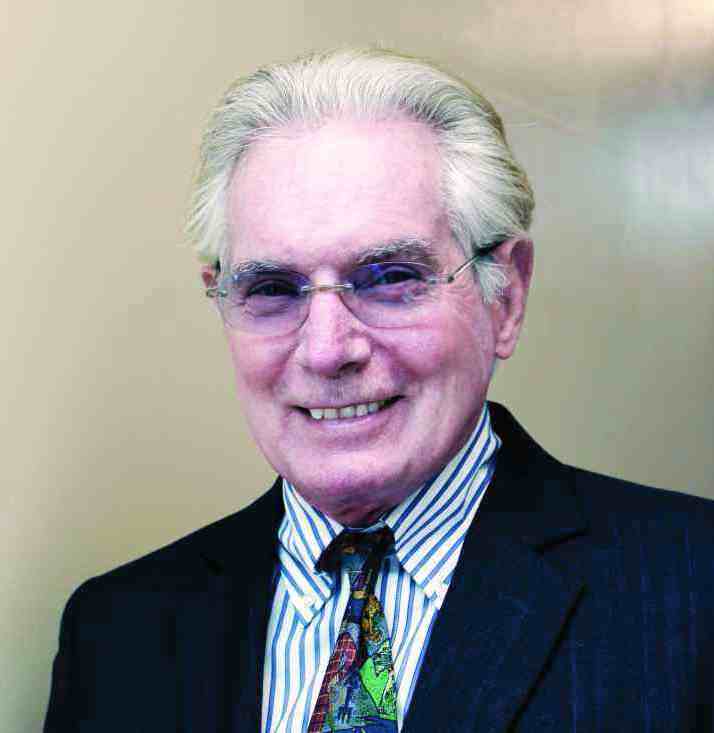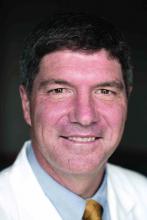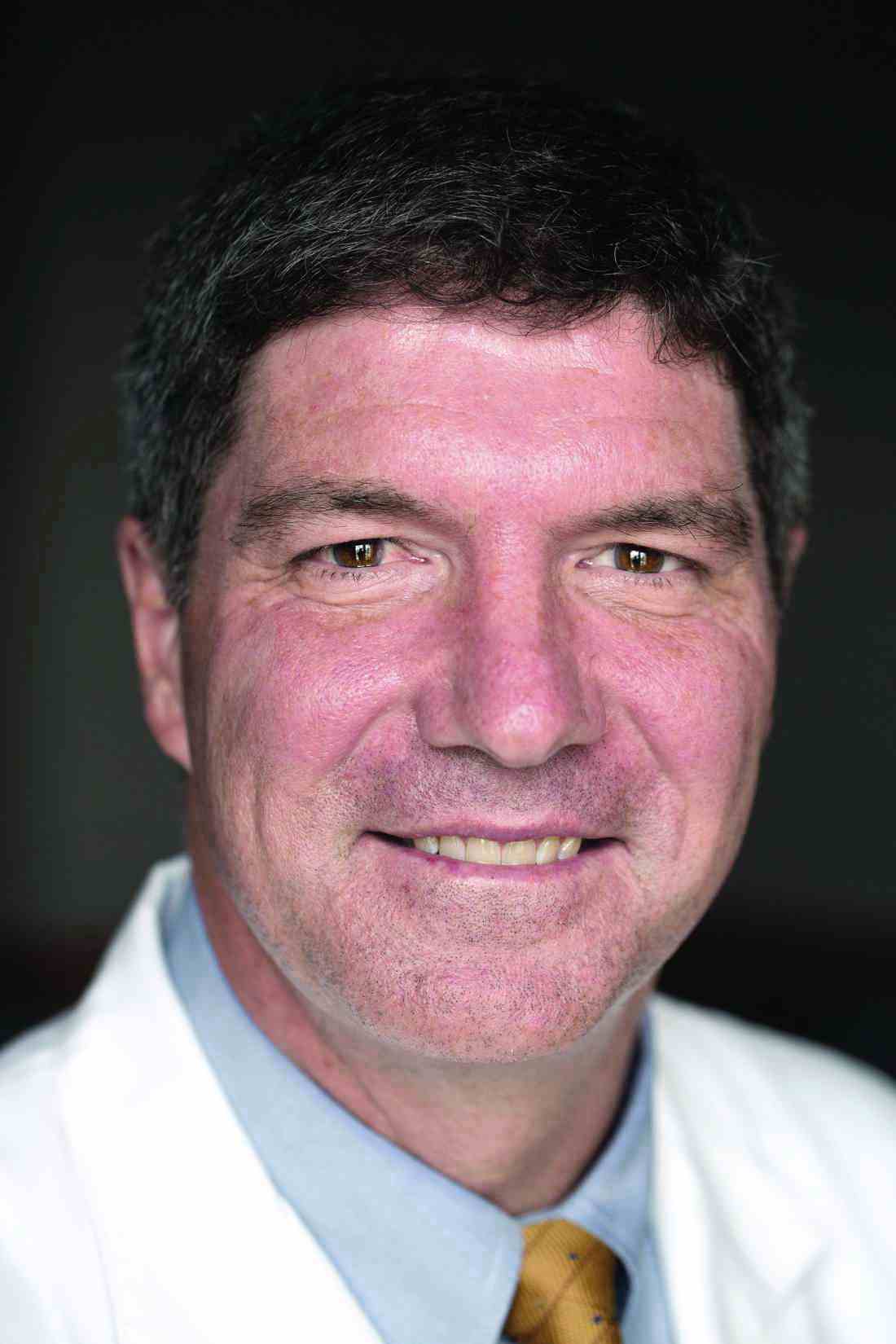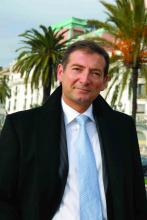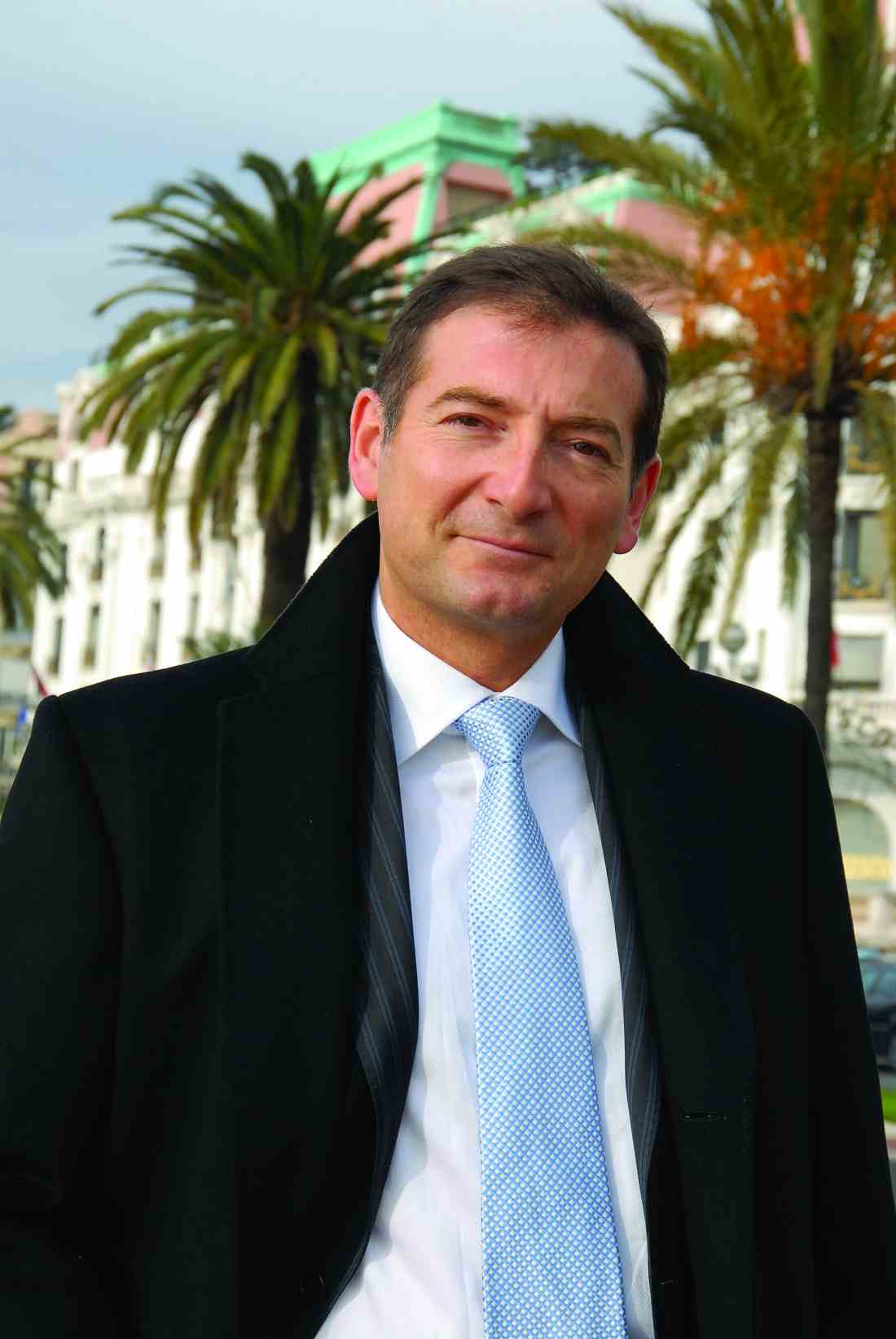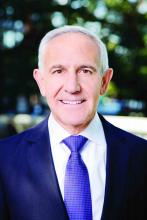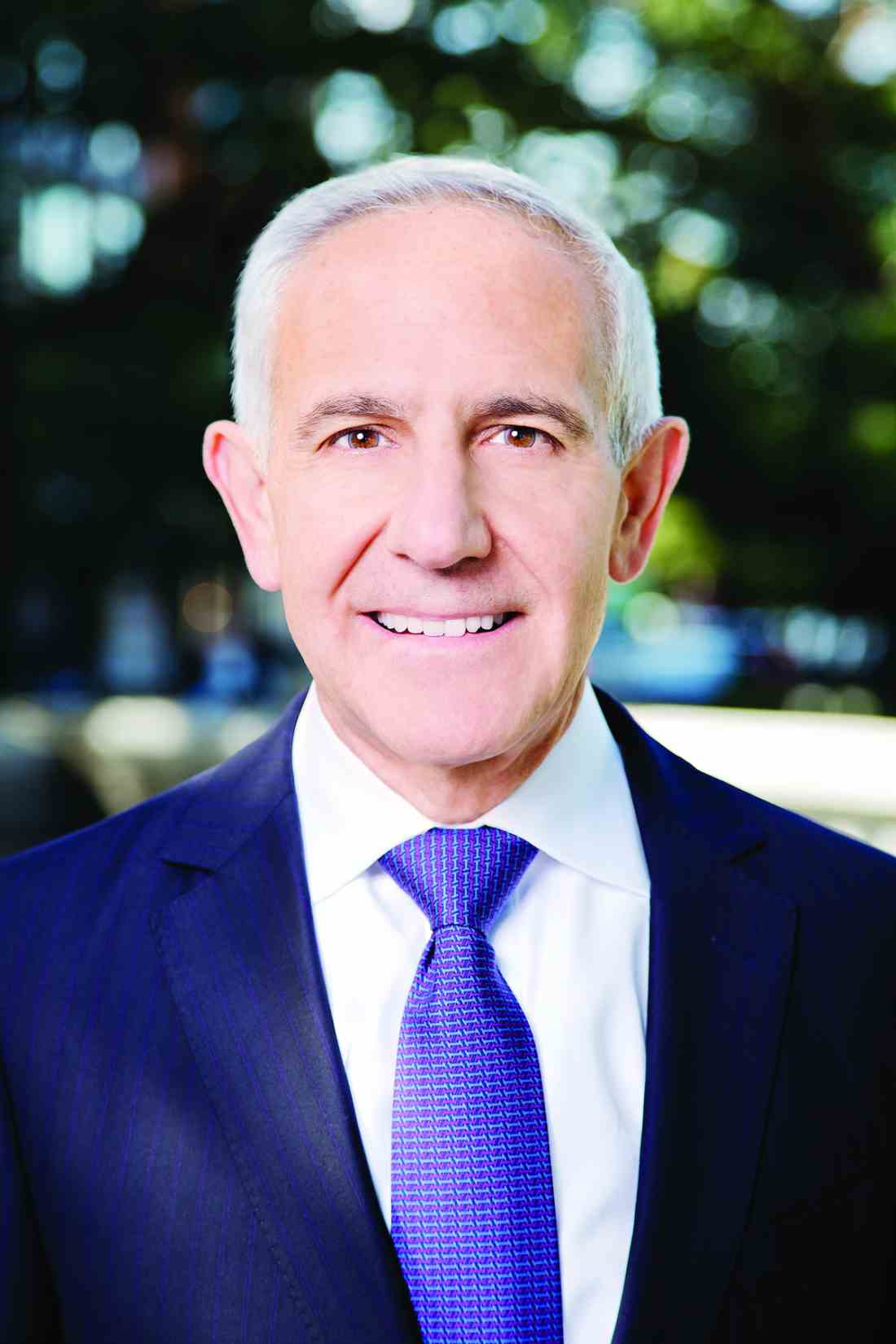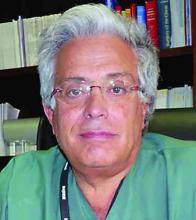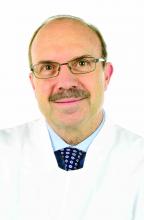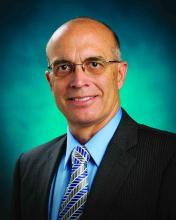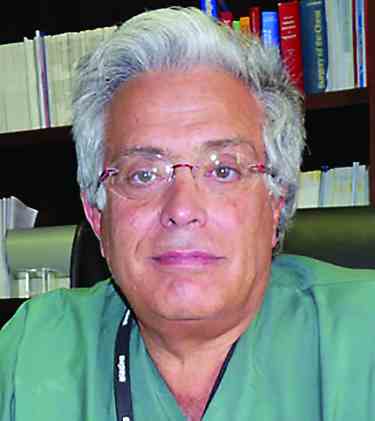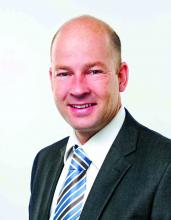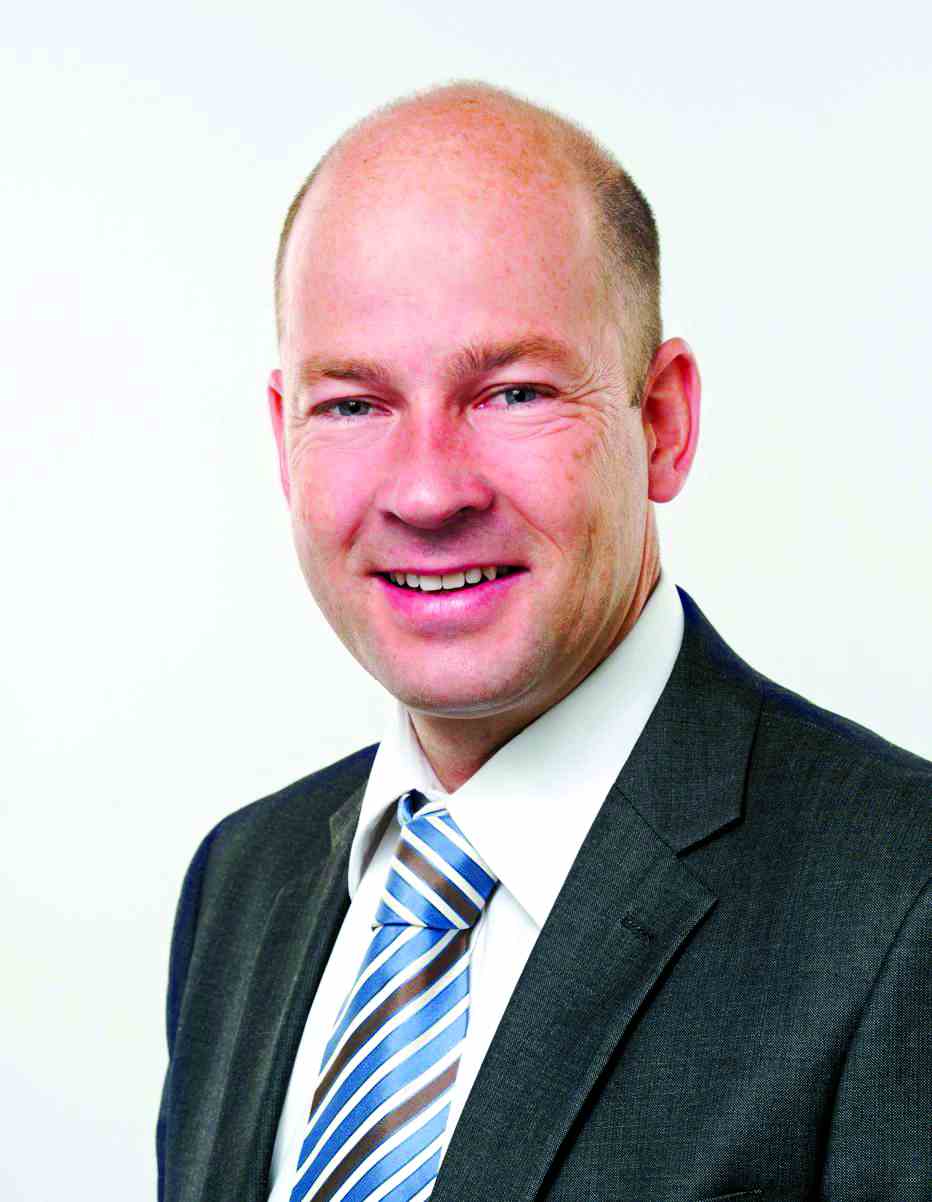User login
Highlight on Innovative Devices for Embolectomy, Clot Retrieval, and Embolization
With the development of ever-more-sophisticated endovascular intervention systems, limb ischemia need no longer be an automatic sentence of lifelong pain or amputation.
But the burgeoning supply of these specialized devices brings its own challenge to the area of endovascular intervention. Which device is best for which patient? And which have strong data to back up their claims of effectiveness? Thursday’s session, “New Devices for Embolectomy, Clot Removal, and Embolization,” will offer some guidance.
“The presentations represent significant further advances in methods and technology that can treat patients with severe, limb-threatening, and life-altering vascular diseases,” said Dr. McNamara. “Also, comparisons are made between competing new technologies. This will be very helpful in deciding which method and/or technology to use. And it will, I think, be very helpful in deciding whether to use interventional or open surgical treatments.“These presentations will not only guide the vascular specialist, but help to substantiate that the interventional techniques continue to be more and more effective. This information could, and should, be shared with primary care physicians.”
This point can’t be underestimated, Dr. McNamara noted. Primary care physicians are on the front line of venous disorders, and should know that there are good treatment options for many patients – treatments than can save limbs and vastly improve pain and function.
“An increasing percentage of patients should be referred for consultation and possible treatments for arterial and venous disease. This will result in decreased morbidity and improved quality of life for an increasing number of patients.”
Surgeons should expect to see more and more such patients as the U.S. population continues to age – and effective treatment not only benefits each individual, but society as a whole.
“The disease significantly decreases the quality of life, and reduces the independence of our aging population. This significantly increases the costs, and increases the burden to society and families of the growing percentage of our population in their ‘Golden Years.’”
The session opens with a lecture by Dr. Ali Amin, a vascular surgeon from West Reading, Pa. He will discuss the role of mechanical thrombectomy and thrombolysis in acute limb ischemia, and when open surgery rather than endovascular intervention is indicated
Dr. Jos C. van den Berg of the University of Bern, Switzerland, will then tackle how to utilize suction techniques and devices to deal with the embolic complications of peripheral vascular interventions.
Rotarex and Aspirex, two mechanical debulking devices created by Straub Med, will be the topic of a presentation by Dr. Michael K.W. Lichtenberg chief of the Angiology Clinic and Venous Center at Klinikum Arnsberg, Germany.
There will be three presentations on thrombectomy with the Indigo System by Penumbra. Indigo provides mechanical clot engagement and vacuum extraction and can be used in both arteries and veins.
Dr. James F. Benenati, of Florida International University Herbert Wertheim College of Medicine, and Dr. Richard R. Saxon of San Diego Imaging, will discuss the PRISM Registry data. The registry recently reported that mechanical aspiration with the Indigo device is a safe and effective option for the treatment of peripheral or visceral arterial occlusions either as a frontline therapy or in patients who failed thrombolysis.
Dr. Frank R. Arko of Carolinas Healthcare System, will share his thoughts on why the Indigo system is an excellent choice for clot removal, and how it decreases the need for lytic therapy.
Dr. George L. Adams, MD, Director of Cardiovascular and Peripheral Vascular Research will make the case for why the Indigo system could be a “game-changer” in the treatment of acute limb ischemia and visceral artery thomboses and emboli.
Dr. Andrej Schmidt of the University Clinic of Leipzig, Germany, will discuss the advantages and limitations of several other Penumbra products, including the Ruby Coil for peripheral embolization, and the Penumbra Occlusion Device (POD). He will also touch on the Lantern microcatheter, Penumbra’s newest product, launched in April. The low-profile, high-flow microcatheter can pass through the distal vasculature, but can also be used for high-flow contrast injections.
Finally, Dr. Aaron Fischman of Mount Sinai Medical Center, will speak on the challenge of endovascular rescue procedures for acute visceral ischemia from thromboembolism.
Session 62
“New Devices for Embolectomy, Clot Removal, and Embolization”
4:32 p.m. – 5:30 p.m.
Grand Ballroom West, 3rd Floor
With the development of ever-more-sophisticated endovascular intervention systems, limb ischemia need no longer be an automatic sentence of lifelong pain or amputation.
But the burgeoning supply of these specialized devices brings its own challenge to the area of endovascular intervention. Which device is best for which patient? And which have strong data to back up their claims of effectiveness? Thursday’s session, “New Devices for Embolectomy, Clot Removal, and Embolization,” will offer some guidance.
“The presentations represent significant further advances in methods and technology that can treat patients with severe, limb-threatening, and life-altering vascular diseases,” said Dr. McNamara. “Also, comparisons are made between competing new technologies. This will be very helpful in deciding which method and/or technology to use. And it will, I think, be very helpful in deciding whether to use interventional or open surgical treatments.“These presentations will not only guide the vascular specialist, but help to substantiate that the interventional techniques continue to be more and more effective. This information could, and should, be shared with primary care physicians.”
This point can’t be underestimated, Dr. McNamara noted. Primary care physicians are on the front line of venous disorders, and should know that there are good treatment options for many patients – treatments than can save limbs and vastly improve pain and function.
“An increasing percentage of patients should be referred for consultation and possible treatments for arterial and venous disease. This will result in decreased morbidity and improved quality of life for an increasing number of patients.”
Surgeons should expect to see more and more such patients as the U.S. population continues to age – and effective treatment not only benefits each individual, but society as a whole.
“The disease significantly decreases the quality of life, and reduces the independence of our aging population. This significantly increases the costs, and increases the burden to society and families of the growing percentage of our population in their ‘Golden Years.’”
The session opens with a lecture by Dr. Ali Amin, a vascular surgeon from West Reading, Pa. He will discuss the role of mechanical thrombectomy and thrombolysis in acute limb ischemia, and when open surgery rather than endovascular intervention is indicated
Dr. Jos C. van den Berg of the University of Bern, Switzerland, will then tackle how to utilize suction techniques and devices to deal with the embolic complications of peripheral vascular interventions.
Rotarex and Aspirex, two mechanical debulking devices created by Straub Med, will be the topic of a presentation by Dr. Michael K.W. Lichtenberg chief of the Angiology Clinic and Venous Center at Klinikum Arnsberg, Germany.
There will be three presentations on thrombectomy with the Indigo System by Penumbra. Indigo provides mechanical clot engagement and vacuum extraction and can be used in both arteries and veins.
Dr. James F. Benenati, of Florida International University Herbert Wertheim College of Medicine, and Dr. Richard R. Saxon of San Diego Imaging, will discuss the PRISM Registry data. The registry recently reported that mechanical aspiration with the Indigo device is a safe and effective option for the treatment of peripheral or visceral arterial occlusions either as a frontline therapy or in patients who failed thrombolysis.
Dr. Frank R. Arko of Carolinas Healthcare System, will share his thoughts on why the Indigo system is an excellent choice for clot removal, and how it decreases the need for lytic therapy.
Dr. George L. Adams, MD, Director of Cardiovascular and Peripheral Vascular Research will make the case for why the Indigo system could be a “game-changer” in the treatment of acute limb ischemia and visceral artery thomboses and emboli.
Dr. Andrej Schmidt of the University Clinic of Leipzig, Germany, will discuss the advantages and limitations of several other Penumbra products, including the Ruby Coil for peripheral embolization, and the Penumbra Occlusion Device (POD). He will also touch on the Lantern microcatheter, Penumbra’s newest product, launched in April. The low-profile, high-flow microcatheter can pass through the distal vasculature, but can also be used for high-flow contrast injections.
Finally, Dr. Aaron Fischman of Mount Sinai Medical Center, will speak on the challenge of endovascular rescue procedures for acute visceral ischemia from thromboembolism.
Session 62
“New Devices for Embolectomy, Clot Removal, and Embolization”
4:32 p.m. – 5:30 p.m.
Grand Ballroom West, 3rd Floor
With the development of ever-more-sophisticated endovascular intervention systems, limb ischemia need no longer be an automatic sentence of lifelong pain or amputation.
But the burgeoning supply of these specialized devices brings its own challenge to the area of endovascular intervention. Which device is best for which patient? And which have strong data to back up their claims of effectiveness? Thursday’s session, “New Devices for Embolectomy, Clot Removal, and Embolization,” will offer some guidance.
“The presentations represent significant further advances in methods and technology that can treat patients with severe, limb-threatening, and life-altering vascular diseases,” said Dr. McNamara. “Also, comparisons are made between competing new technologies. This will be very helpful in deciding which method and/or technology to use. And it will, I think, be very helpful in deciding whether to use interventional or open surgical treatments.“These presentations will not only guide the vascular specialist, but help to substantiate that the interventional techniques continue to be more and more effective. This information could, and should, be shared with primary care physicians.”
This point can’t be underestimated, Dr. McNamara noted. Primary care physicians are on the front line of venous disorders, and should know that there are good treatment options for many patients – treatments than can save limbs and vastly improve pain and function.
“An increasing percentage of patients should be referred for consultation and possible treatments for arterial and venous disease. This will result in decreased morbidity and improved quality of life for an increasing number of patients.”
Surgeons should expect to see more and more such patients as the U.S. population continues to age – and effective treatment not only benefits each individual, but society as a whole.
“The disease significantly decreases the quality of life, and reduces the independence of our aging population. This significantly increases the costs, and increases the burden to society and families of the growing percentage of our population in their ‘Golden Years.’”
The session opens with a lecture by Dr. Ali Amin, a vascular surgeon from West Reading, Pa. He will discuss the role of mechanical thrombectomy and thrombolysis in acute limb ischemia, and when open surgery rather than endovascular intervention is indicated
Dr. Jos C. van den Berg of the University of Bern, Switzerland, will then tackle how to utilize suction techniques and devices to deal with the embolic complications of peripheral vascular interventions.
Rotarex and Aspirex, two mechanical debulking devices created by Straub Med, will be the topic of a presentation by Dr. Michael K.W. Lichtenberg chief of the Angiology Clinic and Venous Center at Klinikum Arnsberg, Germany.
There will be three presentations on thrombectomy with the Indigo System by Penumbra. Indigo provides mechanical clot engagement and vacuum extraction and can be used in both arteries and veins.
Dr. James F. Benenati, of Florida International University Herbert Wertheim College of Medicine, and Dr. Richard R. Saxon of San Diego Imaging, will discuss the PRISM Registry data. The registry recently reported that mechanical aspiration with the Indigo device is a safe and effective option for the treatment of peripheral or visceral arterial occlusions either as a frontline therapy or in patients who failed thrombolysis.
Dr. Frank R. Arko of Carolinas Healthcare System, will share his thoughts on why the Indigo system is an excellent choice for clot removal, and how it decreases the need for lytic therapy.
Dr. George L. Adams, MD, Director of Cardiovascular and Peripheral Vascular Research will make the case for why the Indigo system could be a “game-changer” in the treatment of acute limb ischemia and visceral artery thomboses and emboli.
Dr. Andrej Schmidt of the University Clinic of Leipzig, Germany, will discuss the advantages and limitations of several other Penumbra products, including the Ruby Coil for peripheral embolization, and the Penumbra Occlusion Device (POD). He will also touch on the Lantern microcatheter, Penumbra’s newest product, launched in April. The low-profile, high-flow microcatheter can pass through the distal vasculature, but can also be used for high-flow contrast injections.
Finally, Dr. Aaron Fischman of Mount Sinai Medical Center, will speak on the challenge of endovascular rescue procedures for acute visceral ischemia from thromboembolism.
Session 62
“New Devices for Embolectomy, Clot Removal, and Embolization”
4:32 p.m. – 5:30 p.m.
Grand Ballroom West, 3rd Floor
Study of Bioengineered Vessels for Dialysis Vascular Access Promising
The idea of using bioengineered human acellular vessels for dialysis vascular access used to be a pie-in-the-sky notion, but research presented today will demonstrate just how close they are to becoming a realistic option.
Dr. Jeffrey H. Lawson will present results from two Phase II single-arm trials of bioengineered human acellular vessels for dialysis access in 60 patients with end-stage renal disease conducted in six hospitals: three in the United States and three in Poland. His presentation is entitled “Tissue Engineered Blood Vessels for Arterial Bypass and Dialysis Access: Midterm Results n Patients.” To date, the early clinical experience with these vessels “suggests that they are safe to implant as a dialysis access vessel and lower leg bypass graft,” said Dr. Lawson, chief medical officer at Humacyte and professor of surgery and pathology in the department of surgery at Duke University, Durham, N.C. “They enjoy enduring patency, tolerate needed interventions, appear durable and have a low risk of infection.”
The researchers observed that during 82 patient-years of follow-up, only one vessel became infected. The vessels had no dilatation and rarely had postcannulation bleeding. At 6 months, 63% of patients had primary patency, 73% had primary assisted patency, and 97% had secondary patency, with most loss of primary patency because of thrombosis. At 1 year, 28% had primary patency, 38% had primary assisted patency, and 89% had secondary patency. “Following implantation into patients, the human acellular vessel (HAV) appears to completely repopulate with the host’s (recipient’s) own vascular tissue,” Dr. Lawson said. “The vessel is filled with cells that look like vascular smooth muscle cells and the implanted vessel is lined with endothelial cells from the host, suggesting that the manufactured acellular vessel becomes repopulated with the hosts own cells making it part of their own body. I will also be discussing some unpublished work that we have done for lower leg arterial bypass work in 20 patients to date.”
Dr. Lawson acknowledged that the Phase II experience at a few clinical sites is a limitation of the current analysis. “These findings need to be confirmed and validated in a large Phase III clinical trial, which is now underway,” he said.
Session 60
“New Developments in Arterial Grafts; Stents and Stent-Grafts; Concepts and Techniques to Improve Their Use and Results”
Thursday, 1:54 p.m.– 3:24 p.m.
Grand Ballroom East, 3rd Floor
The idea of using bioengineered human acellular vessels for dialysis vascular access used to be a pie-in-the-sky notion, but research presented today will demonstrate just how close they are to becoming a realistic option.
Dr. Jeffrey H. Lawson will present results from two Phase II single-arm trials of bioengineered human acellular vessels for dialysis access in 60 patients with end-stage renal disease conducted in six hospitals: three in the United States and three in Poland. His presentation is entitled “Tissue Engineered Blood Vessels for Arterial Bypass and Dialysis Access: Midterm Results n Patients.” To date, the early clinical experience with these vessels “suggests that they are safe to implant as a dialysis access vessel and lower leg bypass graft,” said Dr. Lawson, chief medical officer at Humacyte and professor of surgery and pathology in the department of surgery at Duke University, Durham, N.C. “They enjoy enduring patency, tolerate needed interventions, appear durable and have a low risk of infection.”
The researchers observed that during 82 patient-years of follow-up, only one vessel became infected. The vessels had no dilatation and rarely had postcannulation bleeding. At 6 months, 63% of patients had primary patency, 73% had primary assisted patency, and 97% had secondary patency, with most loss of primary patency because of thrombosis. At 1 year, 28% had primary patency, 38% had primary assisted patency, and 89% had secondary patency. “Following implantation into patients, the human acellular vessel (HAV) appears to completely repopulate with the host’s (recipient’s) own vascular tissue,” Dr. Lawson said. “The vessel is filled with cells that look like vascular smooth muscle cells and the implanted vessel is lined with endothelial cells from the host, suggesting that the manufactured acellular vessel becomes repopulated with the hosts own cells making it part of their own body. I will also be discussing some unpublished work that we have done for lower leg arterial bypass work in 20 patients to date.”
Dr. Lawson acknowledged that the Phase II experience at a few clinical sites is a limitation of the current analysis. “These findings need to be confirmed and validated in a large Phase III clinical trial, which is now underway,” he said.
Session 60
“New Developments in Arterial Grafts; Stents and Stent-Grafts; Concepts and Techniques to Improve Their Use and Results”
Thursday, 1:54 p.m.– 3:24 p.m.
Grand Ballroom East, 3rd Floor
The idea of using bioengineered human acellular vessels for dialysis vascular access used to be a pie-in-the-sky notion, but research presented today will demonstrate just how close they are to becoming a realistic option.
Dr. Jeffrey H. Lawson will present results from two Phase II single-arm trials of bioengineered human acellular vessels for dialysis access in 60 patients with end-stage renal disease conducted in six hospitals: three in the United States and three in Poland. His presentation is entitled “Tissue Engineered Blood Vessels for Arterial Bypass and Dialysis Access: Midterm Results n Patients.” To date, the early clinical experience with these vessels “suggests that they are safe to implant as a dialysis access vessel and lower leg bypass graft,” said Dr. Lawson, chief medical officer at Humacyte and professor of surgery and pathology in the department of surgery at Duke University, Durham, N.C. “They enjoy enduring patency, tolerate needed interventions, appear durable and have a low risk of infection.”
The researchers observed that during 82 patient-years of follow-up, only one vessel became infected. The vessels had no dilatation and rarely had postcannulation bleeding. At 6 months, 63% of patients had primary patency, 73% had primary assisted patency, and 97% had secondary patency, with most loss of primary patency because of thrombosis. At 1 year, 28% had primary patency, 38% had primary assisted patency, and 89% had secondary patency. “Following implantation into patients, the human acellular vessel (HAV) appears to completely repopulate with the host’s (recipient’s) own vascular tissue,” Dr. Lawson said. “The vessel is filled with cells that look like vascular smooth muscle cells and the implanted vessel is lined with endothelial cells from the host, suggesting that the manufactured acellular vessel becomes repopulated with the hosts own cells making it part of their own body. I will also be discussing some unpublished work that we have done for lower leg arterial bypass work in 20 patients to date.”
Dr. Lawson acknowledged that the Phase II experience at a few clinical sites is a limitation of the current analysis. “These findings need to be confirmed and validated in a large Phase III clinical trial, which is now underway,” he said.
Session 60
“New Developments in Arterial Grafts; Stents and Stent-Grafts; Concepts and Techniques to Improve Their Use and Results”
Thursday, 1:54 p.m.– 3:24 p.m.
Grand Ballroom East, 3rd Floor
ASVAL Can Save Refluxing Saphenous Veins
Ambulatory selective varicose vein ablation under local anesthesia (ASVAL) can abolish reflux while preserving the great saphenous vein, and benefits can last at least a decade, said Dr. Silvain Chastanet, who helped create the technique and will discuss it Thursday morning.
Historically, a refluxing great saphenous vein was treated by removing it. The ASVAL method preserves the vein by using microphlebotomy to instead remove the varicose reservoir, said Dr. Chastanet of the Riviera Vein Institute in Monaco. “Because each patient is different, this strategy offers tailored, à la carte treatment, as opposed to systematic ablation,” he said. “Doing precise and thorough microphlebectomies is not as simple as one might think, but we will share tips and tricks for performing saphenous sparing venous surgery in an easy and elegant way.”
The ASVAL technique is based on the premise that reflux usually ascends from the tributaries toward the saphenous trunk, rather than following the opposite path, said Dr. Chastanet. Although the ascending pattern is not universal, increasing evidence suggests that it is most common. For example, a study of more than 700 consecutive patients with chronic venous disease showed that patients of CEAP category C4-C6 had significantly greater involvement of the saphenofemoral junction and saphenopopliteal trunk than patients with less advanced venous disease. The authors concluded that reflux usually ascends up from the tributaries and accessory saphenous veins (J Vasc Surg. 2010;51(1):96-103).
Thus, when evaluating a patient with saphenous reflux, surgeons should always ask whether they can spare the great saphenous vein, Dr. Chastanet said. Evidence indicates that if the patient is classified as C2 (varicose veins) and the great saphenous vein is dilated less than 10 mm, ASVAL may be a valid option, especially if reflux is localized above the knee, with the varices localized to the thigh.
Techniques such as ASVAL are a major advance, but questions persist about surgically treating varicose disease, Dr. Chastanet noted. For example, although ascending disease appears to be most common, it can convert to descending disease or patients can have a refluxing saphenous trunk without tributaries. “We still do not know which patients are likely to have descending or ascending disease, and why,” Dr. Chastanet said. Likewise, experts continue to debate whether phlebectomy should be performed together with saphenous ablation. “Considering that some varicosities will disappear after endothermal ablation of the saphenous vein, some surgeons consider concomitant phlebectomy to be overtreatment,” Dr. Chastenet noted. “Conversely, if we consider that the disease begins at the tributary level according to the ascending theory, it seems obvious to focus treatment on the varicose tributaries, which are the main concern for the majority of patients.”
Bringing techniques such as ASVAL into community practice involves practical challenges, too. Microphlebectomy is “clearly” the best cosmetic option, but is not taught during surgical or phlebology training, Dr. Chastanet said. “There is a need to develop new tools for treating the varicose tributaries in an easier and faster way.” Such advances could help transition procedures such as ASVAL to outpatient settings, which is not now the norm in most countries, he noted. “Using local anesthesia, mini-invasive surgical procedures with immediate ambulation will enable us to reach this goal.”
Session 63
“Venous Clinical Examination and Hemodynamics”
Thursday 8:13 a.m. – 8:18 a.m.
Trianon Ballroom, 3rd Floor
Ambulatory selective varicose vein ablation under local anesthesia (ASVAL) can abolish reflux while preserving the great saphenous vein, and benefits can last at least a decade, said Dr. Silvain Chastanet, who helped create the technique and will discuss it Thursday morning.
Historically, a refluxing great saphenous vein was treated by removing it. The ASVAL method preserves the vein by using microphlebotomy to instead remove the varicose reservoir, said Dr. Chastanet of the Riviera Vein Institute in Monaco. “Because each patient is different, this strategy offers tailored, à la carte treatment, as opposed to systematic ablation,” he said. “Doing precise and thorough microphlebectomies is not as simple as one might think, but we will share tips and tricks for performing saphenous sparing venous surgery in an easy and elegant way.”
The ASVAL technique is based on the premise that reflux usually ascends from the tributaries toward the saphenous trunk, rather than following the opposite path, said Dr. Chastanet. Although the ascending pattern is not universal, increasing evidence suggests that it is most common. For example, a study of more than 700 consecutive patients with chronic venous disease showed that patients of CEAP category C4-C6 had significantly greater involvement of the saphenofemoral junction and saphenopopliteal trunk than patients with less advanced venous disease. The authors concluded that reflux usually ascends up from the tributaries and accessory saphenous veins (J Vasc Surg. 2010;51(1):96-103).
Thus, when evaluating a patient with saphenous reflux, surgeons should always ask whether they can spare the great saphenous vein, Dr. Chastanet said. Evidence indicates that if the patient is classified as C2 (varicose veins) and the great saphenous vein is dilated less than 10 mm, ASVAL may be a valid option, especially if reflux is localized above the knee, with the varices localized to the thigh.
Techniques such as ASVAL are a major advance, but questions persist about surgically treating varicose disease, Dr. Chastanet noted. For example, although ascending disease appears to be most common, it can convert to descending disease or patients can have a refluxing saphenous trunk without tributaries. “We still do not know which patients are likely to have descending or ascending disease, and why,” Dr. Chastanet said. Likewise, experts continue to debate whether phlebectomy should be performed together with saphenous ablation. “Considering that some varicosities will disappear after endothermal ablation of the saphenous vein, some surgeons consider concomitant phlebectomy to be overtreatment,” Dr. Chastenet noted. “Conversely, if we consider that the disease begins at the tributary level according to the ascending theory, it seems obvious to focus treatment on the varicose tributaries, which are the main concern for the majority of patients.”
Bringing techniques such as ASVAL into community practice involves practical challenges, too. Microphlebectomy is “clearly” the best cosmetic option, but is not taught during surgical or phlebology training, Dr. Chastanet said. “There is a need to develop new tools for treating the varicose tributaries in an easier and faster way.” Such advances could help transition procedures such as ASVAL to outpatient settings, which is not now the norm in most countries, he noted. “Using local anesthesia, mini-invasive surgical procedures with immediate ambulation will enable us to reach this goal.”
Session 63
“Venous Clinical Examination and Hemodynamics”
Thursday 8:13 a.m. – 8:18 a.m.
Trianon Ballroom, 3rd Floor
Ambulatory selective varicose vein ablation under local anesthesia (ASVAL) can abolish reflux while preserving the great saphenous vein, and benefits can last at least a decade, said Dr. Silvain Chastanet, who helped create the technique and will discuss it Thursday morning.
Historically, a refluxing great saphenous vein was treated by removing it. The ASVAL method preserves the vein by using microphlebotomy to instead remove the varicose reservoir, said Dr. Chastanet of the Riviera Vein Institute in Monaco. “Because each patient is different, this strategy offers tailored, à la carte treatment, as opposed to systematic ablation,” he said. “Doing precise and thorough microphlebectomies is not as simple as one might think, but we will share tips and tricks for performing saphenous sparing venous surgery in an easy and elegant way.”
The ASVAL technique is based on the premise that reflux usually ascends from the tributaries toward the saphenous trunk, rather than following the opposite path, said Dr. Chastanet. Although the ascending pattern is not universal, increasing evidence suggests that it is most common. For example, a study of more than 700 consecutive patients with chronic venous disease showed that patients of CEAP category C4-C6 had significantly greater involvement of the saphenofemoral junction and saphenopopliteal trunk than patients with less advanced venous disease. The authors concluded that reflux usually ascends up from the tributaries and accessory saphenous veins (J Vasc Surg. 2010;51(1):96-103).
Thus, when evaluating a patient with saphenous reflux, surgeons should always ask whether they can spare the great saphenous vein, Dr. Chastanet said. Evidence indicates that if the patient is classified as C2 (varicose veins) and the great saphenous vein is dilated less than 10 mm, ASVAL may be a valid option, especially if reflux is localized above the knee, with the varices localized to the thigh.
Techniques such as ASVAL are a major advance, but questions persist about surgically treating varicose disease, Dr. Chastanet noted. For example, although ascending disease appears to be most common, it can convert to descending disease or patients can have a refluxing saphenous trunk without tributaries. “We still do not know which patients are likely to have descending or ascending disease, and why,” Dr. Chastanet said. Likewise, experts continue to debate whether phlebectomy should be performed together with saphenous ablation. “Considering that some varicosities will disappear after endothermal ablation of the saphenous vein, some surgeons consider concomitant phlebectomy to be overtreatment,” Dr. Chastenet noted. “Conversely, if we consider that the disease begins at the tributary level according to the ascending theory, it seems obvious to focus treatment on the varicose tributaries, which are the main concern for the majority of patients.”
Bringing techniques such as ASVAL into community practice involves practical challenges, too. Microphlebectomy is “clearly” the best cosmetic option, but is not taught during surgical or phlebology training, Dr. Chastanet said. “There is a need to develop new tools for treating the varicose tributaries in an easier and faster way.” Such advances could help transition procedures such as ASVAL to outpatient settings, which is not now the norm in most countries, he noted. “Using local anesthesia, mini-invasive surgical procedures with immediate ambulation will enable us to reach this goal.”
Session 63
“Venous Clinical Examination and Hemodynamics”
Thursday 8:13 a.m. – 8:18 a.m.
Trianon Ballroom, 3rd Floor
Treating Lower Arterial Occlusive Disease
How to proceed when a patient needs a bypass that can’t be done using the saphenous vein, and how to measure arterial flow to the foot are two novel areas that help improve a revascularization algorithm for lower arterial occlusive disease, according to Dr. Kenneth Ouriel, co-moderator of the Wednesday session, “Value of Deep Vein Grafts; New Concepts in Assessing Foot Perfusion and Improving It; More About the Angiosome Controversy; Some Ongoing CLI Trials.”
“A lot of patients don’t have a suitable bypass conduit to bring blood to the lower limb. But when the saphenous vein isn’t available, and you’re concerned an artificial graft won’t be as effective, there is another alternative,” said Dr. Ouriel, president and CEO of the New York–based clinical research firm, Syntactx.
Dr. Ouriel said “it’s also a vein that is not that long, so if you need a long vein for a bypass, from the top of the leg to the ankle, for example, it might not be long enough.”
Clinicians who attend this session also will be able to incorporate novel ways of quantifying perfusion to the foot, according to Dr. Ouriel. “The angiosome isn’t controversial so much as just new. Most of us didn’t learn about it in medical school, but we will explore it in depth during this session.”
The general principle of the angiosome is that arterial flow to the foot is “compartmentalized” into regions supplied by discrete vessels. This leads to seeing perfusion not only as a whole, but also in terms of specific regions, said Dr. Ouriel.
By focusing on the revascularization of the source artery to a specific angiosome, data indicate there are better rates of wound healing and limb salvage, according to Dr. Ouriel.
To round out the session are results and questions posed by a series of “exciting” trials both completed and still recruiting, including the LIBERTY, SPINACH, and BEST trials. The discussion of these trial findings will add nuance to the overall discussion about whether surgical reconstruction or peripheral intervention in patients with critical limb ischemia is appropriate and when to do it.
Session 30:
Value of Deep Vein Grafts; New Concepts in Assessing Foot Perfusion and Improving It; More About the Angiosome Controversy; Some Ongoing CLI Trials
Wednesday, 4:22 p.m. – 5:58 p.m.
Grand Ballroom East, 3rd Floor
How to proceed when a patient needs a bypass that can’t be done using the saphenous vein, and how to measure arterial flow to the foot are two novel areas that help improve a revascularization algorithm for lower arterial occlusive disease, according to Dr. Kenneth Ouriel, co-moderator of the Wednesday session, “Value of Deep Vein Grafts; New Concepts in Assessing Foot Perfusion and Improving It; More About the Angiosome Controversy; Some Ongoing CLI Trials.”
“A lot of patients don’t have a suitable bypass conduit to bring blood to the lower limb. But when the saphenous vein isn’t available, and you’re concerned an artificial graft won’t be as effective, there is another alternative,” said Dr. Ouriel, president and CEO of the New York–based clinical research firm, Syntactx.
Dr. Ouriel said “it’s also a vein that is not that long, so if you need a long vein for a bypass, from the top of the leg to the ankle, for example, it might not be long enough.”
Clinicians who attend this session also will be able to incorporate novel ways of quantifying perfusion to the foot, according to Dr. Ouriel. “The angiosome isn’t controversial so much as just new. Most of us didn’t learn about it in medical school, but we will explore it in depth during this session.”
The general principle of the angiosome is that arterial flow to the foot is “compartmentalized” into regions supplied by discrete vessels. This leads to seeing perfusion not only as a whole, but also in terms of specific regions, said Dr. Ouriel.
By focusing on the revascularization of the source artery to a specific angiosome, data indicate there are better rates of wound healing and limb salvage, according to Dr. Ouriel.
To round out the session are results and questions posed by a series of “exciting” trials both completed and still recruiting, including the LIBERTY, SPINACH, and BEST trials. The discussion of these trial findings will add nuance to the overall discussion about whether surgical reconstruction or peripheral intervention in patients with critical limb ischemia is appropriate and when to do it.
Session 30:
Value of Deep Vein Grafts; New Concepts in Assessing Foot Perfusion and Improving It; More About the Angiosome Controversy; Some Ongoing CLI Trials
Wednesday, 4:22 p.m. – 5:58 p.m.
Grand Ballroom East, 3rd Floor
How to proceed when a patient needs a bypass that can’t be done using the saphenous vein, and how to measure arterial flow to the foot are two novel areas that help improve a revascularization algorithm for lower arterial occlusive disease, according to Dr. Kenneth Ouriel, co-moderator of the Wednesday session, “Value of Deep Vein Grafts; New Concepts in Assessing Foot Perfusion and Improving It; More About the Angiosome Controversy; Some Ongoing CLI Trials.”
“A lot of patients don’t have a suitable bypass conduit to bring blood to the lower limb. But when the saphenous vein isn’t available, and you’re concerned an artificial graft won’t be as effective, there is another alternative,” said Dr. Ouriel, president and CEO of the New York–based clinical research firm, Syntactx.
Dr. Ouriel said “it’s also a vein that is not that long, so if you need a long vein for a bypass, from the top of the leg to the ankle, for example, it might not be long enough.”
Clinicians who attend this session also will be able to incorporate novel ways of quantifying perfusion to the foot, according to Dr. Ouriel. “The angiosome isn’t controversial so much as just new. Most of us didn’t learn about it in medical school, but we will explore it in depth during this session.”
The general principle of the angiosome is that arterial flow to the foot is “compartmentalized” into regions supplied by discrete vessels. This leads to seeing perfusion not only as a whole, but also in terms of specific regions, said Dr. Ouriel.
By focusing on the revascularization of the source artery to a specific angiosome, data indicate there are better rates of wound healing and limb salvage, according to Dr. Ouriel.
To round out the session are results and questions posed by a series of “exciting” trials both completed and still recruiting, including the LIBERTY, SPINACH, and BEST trials. The discussion of these trial findings will add nuance to the overall discussion about whether surgical reconstruction or peripheral intervention in patients with critical limb ischemia is appropriate and when to do it.
Session 30:
Value of Deep Vein Grafts; New Concepts in Assessing Foot Perfusion and Improving It; More About the Angiosome Controversy; Some Ongoing CLI Trials
Wednesday, 4:22 p.m. – 5:58 p.m.
Grand Ballroom East, 3rd Floor
Innovations in treating AAA: Innovative Endovascular Approaches
Aortic aneurysms involving aortic branches pose significant challenges for open and endovascular repair. Tuesday morning’s session, “New Developments with Juxta and Pararenal Aortic Aneurysms and Thoracoabdominal Aneurysms,” will be a discussion of surgical experiences with the first fenestrated graft approved in the United States and a review several other approaches to treatment.
The session will provide “an important update about the most recent advances in this field,” Dr. Cao added. “It will be focused on the most recent adjuncts to be used not only in patients with a failed EVAR but also in preventing the failure as well as the indications for using endovascular versus an open approach.”
The session kicks off with presentations on the current status of ZFEN by Dr. Andres Schanzer of UMass Memorial Medical Center and on circumstances in when superior mesenteric artery (SMA) scallops can cause problems during F/EVAR with ZFEN by Dr. Carlos Timaran of the University of Texas Southwestern Medical School.
“The topics covered in this session will aid vascular surgeons in deciding the best approach to treat such patients, by emphasizing the strengths, weaknesses, and limitations of the various options,” he said. “Tips and tricks to address specific circumstances can be invaluable in optimizing patient outcomes.”
The last portion of the session will cover F/EVAR for failed EVAR, including when F/EVAR is indicated, adjuncts to improve outcomes of treatment for challenging AAAs, and branched EVAR (B/EVAR). The session will wrap with a presentation by Dr. Piotr Szopinski of the Medical University of Warsaw on early clinical results from the COLT endograft system for treatment of thoracoabdominal aortic aneurysms (TAAAs).
“Attendees will have the opportunity to compare the different treatment options,” Dr. Torsello said. “We look forward to an open discussion that will lead to practical guidelines for decision making. The audience can develop their own treatment algorithms for patients with hostile or absent aortic aneurysm neck.”
“We currently have multiple modalities to prevent and treat complications,” Dr. Cao said. “Vascular surgeons should be familiar with different techniques and should tailor their approach to each patient according to the morphology of the native aorta and access vessels, as well as the clinical conditions and risk factors for open surgery.”
Session 12:
New Developments with Juxta and Pararenal Aortic Aneurysms and Thoracoabdominal Aneurysms
Tuesday, 10:20 a.m. – 12:00 p.m.
Grand Ballroom West, 3 rd Floor
Aortic aneurysms involving aortic branches pose significant challenges for open and endovascular repair. Tuesday morning’s session, “New Developments with Juxta and Pararenal Aortic Aneurysms and Thoracoabdominal Aneurysms,” will be a discussion of surgical experiences with the first fenestrated graft approved in the United States and a review several other approaches to treatment.
The session will provide “an important update about the most recent advances in this field,” Dr. Cao added. “It will be focused on the most recent adjuncts to be used not only in patients with a failed EVAR but also in preventing the failure as well as the indications for using endovascular versus an open approach.”
The session kicks off with presentations on the current status of ZFEN by Dr. Andres Schanzer of UMass Memorial Medical Center and on circumstances in when superior mesenteric artery (SMA) scallops can cause problems during F/EVAR with ZFEN by Dr. Carlos Timaran of the University of Texas Southwestern Medical School.
“The topics covered in this session will aid vascular surgeons in deciding the best approach to treat such patients, by emphasizing the strengths, weaknesses, and limitations of the various options,” he said. “Tips and tricks to address specific circumstances can be invaluable in optimizing patient outcomes.”
The last portion of the session will cover F/EVAR for failed EVAR, including when F/EVAR is indicated, adjuncts to improve outcomes of treatment for challenging AAAs, and branched EVAR (B/EVAR). The session will wrap with a presentation by Dr. Piotr Szopinski of the Medical University of Warsaw on early clinical results from the COLT endograft system for treatment of thoracoabdominal aortic aneurysms (TAAAs).
“Attendees will have the opportunity to compare the different treatment options,” Dr. Torsello said. “We look forward to an open discussion that will lead to practical guidelines for decision making. The audience can develop their own treatment algorithms for patients with hostile or absent aortic aneurysm neck.”
“We currently have multiple modalities to prevent and treat complications,” Dr. Cao said. “Vascular surgeons should be familiar with different techniques and should tailor their approach to each patient according to the morphology of the native aorta and access vessels, as well as the clinical conditions and risk factors for open surgery.”
Session 12:
New Developments with Juxta and Pararenal Aortic Aneurysms and Thoracoabdominal Aneurysms
Tuesday, 10:20 a.m. – 12:00 p.m.
Grand Ballroom West, 3 rd Floor
Aortic aneurysms involving aortic branches pose significant challenges for open and endovascular repair. Tuesday morning’s session, “New Developments with Juxta and Pararenal Aortic Aneurysms and Thoracoabdominal Aneurysms,” will be a discussion of surgical experiences with the first fenestrated graft approved in the United States and a review several other approaches to treatment.
The session will provide “an important update about the most recent advances in this field,” Dr. Cao added. “It will be focused on the most recent adjuncts to be used not only in patients with a failed EVAR but also in preventing the failure as well as the indications for using endovascular versus an open approach.”
The session kicks off with presentations on the current status of ZFEN by Dr. Andres Schanzer of UMass Memorial Medical Center and on circumstances in when superior mesenteric artery (SMA) scallops can cause problems during F/EVAR with ZFEN by Dr. Carlos Timaran of the University of Texas Southwestern Medical School.
“The topics covered in this session will aid vascular surgeons in deciding the best approach to treat such patients, by emphasizing the strengths, weaknesses, and limitations of the various options,” he said. “Tips and tricks to address specific circumstances can be invaluable in optimizing patient outcomes.”
The last portion of the session will cover F/EVAR for failed EVAR, including when F/EVAR is indicated, adjuncts to improve outcomes of treatment for challenging AAAs, and branched EVAR (B/EVAR). The session will wrap with a presentation by Dr. Piotr Szopinski of the Medical University of Warsaw on early clinical results from the COLT endograft system for treatment of thoracoabdominal aortic aneurysms (TAAAs).
“Attendees will have the opportunity to compare the different treatment options,” Dr. Torsello said. “We look forward to an open discussion that will lead to practical guidelines for decision making. The audience can develop their own treatment algorithms for patients with hostile or absent aortic aneurysm neck.”
“We currently have multiple modalities to prevent and treat complications,” Dr. Cao said. “Vascular surgeons should be familiar with different techniques and should tailor their approach to each patient according to the morphology of the native aorta and access vessels, as well as the clinical conditions and risk factors for open surgery.”
Session 12:
New Developments with Juxta and Pararenal Aortic Aneurysms and Thoracoabdominal Aneurysms
Tuesday, 10:20 a.m. – 12:00 p.m.
Grand Ballroom West, 3 rd Floor
Session Tackles Merits and Shortcomings of Drug Coated Balloons
Most vascular surgeons have a preferred method for managing femoropopliteal lesions, but drug-coated balloons are emerging as a option for lower extremity lesions.
The Wednesday morning session, “More on Lower Extremity Occlusive Disease: New Developments in Drug Coated Balloons (DCBs); Dealing with Complex Lesions and Trials,” will feature opposing views on how to manage the most severe disease morphology.
In this important session, world renown experts also will discuss the current status and immediate future of drug-coated balloons (DCB) for use on the lower extremity.
“The treatment with DCB is a story of great success. In general, the patency rate is increased and this is with no side effects due to the coating,” said Dr. Gunnar Tepe of Rosenheim Hospital in Rosenheim, Germany. “In the near future treatment with uncoated balloons will be mainly replaced by DCBs.” Dr. Tepe will present a paper on the current status and future prospects of DCBs.
Understanding important technical aspects remains essential to successful outcomes with DCBs, according to Dr. Tepe. “We have to know that treatment with DCBs is not a stand-alone therapy which can be successful in all lesions,” said Dr. Tepe. “If DCBs fail to obtain long-term patency, it is either due to recoil or drug uptake. For recoil, the combination of DCBs and stents is perfect, but for better drug uptake vessel, preparation is needed.”
Dr. Tepe and others will offer a detailed analysis of the potential shortcomings of DCBs, such as in long lesions, and in calcified arteries, and how to overcome them.
“The future of DCBs for use in patients with the potential threat of amputation is under development internationally,” said Dr. Schneider. “Practitioners will leave the session fully updated on the latest data and analysis of the value of DCBs in daily practice, since the most current results from randomized trials, and large registry datasets from the United States and around the world will be presented side by side.”
The presentations include the 3-year results from the international, randomized, controlled IN.PACT SFA Trial that compared the IN.PACT DCB against standard angioplasty. On hand to analyze and discuss the results will be co-principal investigators Dr. Schneider, Dr. Tepe, as well as panelist Dr. John R. Laird of the Vascular Center at the University of California, Davis. Co-moderator and study investigator Dr. Dierk Scheinert, MD, of the Leipzig University Hospital in Germany, will also join the discussion.
“I believe the data will show that DCBs have significantly changed how we practice and that by using them when possible, we can substantially improve what we can offer to patients in terms of long-term durability of the reconstructions we perform for their blocked and damaged arteries,” Dr. Tepe said.
The session will also cover second- and third-generation DCBs that are currently under development.
“As has been the tradition for many years, the VEITH planning committee has been able to bring together the world experts with the most important experience in these topics to educate, debate, inform the broader community,” said Dr. Schneider.
Session 26:
More on Lower Extremity Occlusive Disease: New Developments in Drug Coated Balloons (DCBs); Dealing with Complex Lesions and Trials
Wednesday 10:13 p.m. –12:00 p.m.
Grand Ballroom East, 3rd Floor
Most vascular surgeons have a preferred method for managing femoropopliteal lesions, but drug-coated balloons are emerging as a option for lower extremity lesions.
The Wednesday morning session, “More on Lower Extremity Occlusive Disease: New Developments in Drug Coated Balloons (DCBs); Dealing with Complex Lesions and Trials,” will feature opposing views on how to manage the most severe disease morphology.
In this important session, world renown experts also will discuss the current status and immediate future of drug-coated balloons (DCB) for use on the lower extremity.
“The treatment with DCB is a story of great success. In general, the patency rate is increased and this is with no side effects due to the coating,” said Dr. Gunnar Tepe of Rosenheim Hospital in Rosenheim, Germany. “In the near future treatment with uncoated balloons will be mainly replaced by DCBs.” Dr. Tepe will present a paper on the current status and future prospects of DCBs.
Understanding important technical aspects remains essential to successful outcomes with DCBs, according to Dr. Tepe. “We have to know that treatment with DCBs is not a stand-alone therapy which can be successful in all lesions,” said Dr. Tepe. “If DCBs fail to obtain long-term patency, it is either due to recoil or drug uptake. For recoil, the combination of DCBs and stents is perfect, but for better drug uptake vessel, preparation is needed.”
Dr. Tepe and others will offer a detailed analysis of the potential shortcomings of DCBs, such as in long lesions, and in calcified arteries, and how to overcome them.
“The future of DCBs for use in patients with the potential threat of amputation is under development internationally,” said Dr. Schneider. “Practitioners will leave the session fully updated on the latest data and analysis of the value of DCBs in daily practice, since the most current results from randomized trials, and large registry datasets from the United States and around the world will be presented side by side.”
The presentations include the 3-year results from the international, randomized, controlled IN.PACT SFA Trial that compared the IN.PACT DCB against standard angioplasty. On hand to analyze and discuss the results will be co-principal investigators Dr. Schneider, Dr. Tepe, as well as panelist Dr. John R. Laird of the Vascular Center at the University of California, Davis. Co-moderator and study investigator Dr. Dierk Scheinert, MD, of the Leipzig University Hospital in Germany, will also join the discussion.
“I believe the data will show that DCBs have significantly changed how we practice and that by using them when possible, we can substantially improve what we can offer to patients in terms of long-term durability of the reconstructions we perform for their blocked and damaged arteries,” Dr. Tepe said.
The session will also cover second- and third-generation DCBs that are currently under development.
“As has been the tradition for many years, the VEITH planning committee has been able to bring together the world experts with the most important experience in these topics to educate, debate, inform the broader community,” said Dr. Schneider.
Session 26:
More on Lower Extremity Occlusive Disease: New Developments in Drug Coated Balloons (DCBs); Dealing with Complex Lesions and Trials
Wednesday 10:13 p.m. –12:00 p.m.
Grand Ballroom East, 3rd Floor
Most vascular surgeons have a preferred method for managing femoropopliteal lesions, but drug-coated balloons are emerging as a option for lower extremity lesions.
The Wednesday morning session, “More on Lower Extremity Occlusive Disease: New Developments in Drug Coated Balloons (DCBs); Dealing with Complex Lesions and Trials,” will feature opposing views on how to manage the most severe disease morphology.
In this important session, world renown experts also will discuss the current status and immediate future of drug-coated balloons (DCB) for use on the lower extremity.
“The treatment with DCB is a story of great success. In general, the patency rate is increased and this is with no side effects due to the coating,” said Dr. Gunnar Tepe of Rosenheim Hospital in Rosenheim, Germany. “In the near future treatment with uncoated balloons will be mainly replaced by DCBs.” Dr. Tepe will present a paper on the current status and future prospects of DCBs.
Understanding important technical aspects remains essential to successful outcomes with DCBs, according to Dr. Tepe. “We have to know that treatment with DCBs is not a stand-alone therapy which can be successful in all lesions,” said Dr. Tepe. “If DCBs fail to obtain long-term patency, it is either due to recoil or drug uptake. For recoil, the combination of DCBs and stents is perfect, but for better drug uptake vessel, preparation is needed.”
Dr. Tepe and others will offer a detailed analysis of the potential shortcomings of DCBs, such as in long lesions, and in calcified arteries, and how to overcome them.
“The future of DCBs for use in patients with the potential threat of amputation is under development internationally,” said Dr. Schneider. “Practitioners will leave the session fully updated on the latest data and analysis of the value of DCBs in daily practice, since the most current results from randomized trials, and large registry datasets from the United States and around the world will be presented side by side.”
The presentations include the 3-year results from the international, randomized, controlled IN.PACT SFA Trial that compared the IN.PACT DCB against standard angioplasty. On hand to analyze and discuss the results will be co-principal investigators Dr. Schneider, Dr. Tepe, as well as panelist Dr. John R. Laird of the Vascular Center at the University of California, Davis. Co-moderator and study investigator Dr. Dierk Scheinert, MD, of the Leipzig University Hospital in Germany, will also join the discussion.
“I believe the data will show that DCBs have significantly changed how we practice and that by using them when possible, we can substantially improve what we can offer to patients in terms of long-term durability of the reconstructions we perform for their blocked and damaged arteries,” Dr. Tepe said.
The session will also cover second- and third-generation DCBs that are currently under development.
“As has been the tradition for many years, the VEITH planning committee has been able to bring together the world experts with the most important experience in these topics to educate, debate, inform the broader community,” said Dr. Schneider.
Session 26:
More on Lower Extremity Occlusive Disease: New Developments in Drug Coated Balloons (DCBs); Dealing with Complex Lesions and Trials
Wednesday 10:13 p.m. –12:00 p.m.
Grand Ballroom East, 3rd Floor
Remembering three giants in vascular surgery
This year the VEITHsymposium will be paying tribute to three influential vascular surgeons who are no longer with us: Dr. Allan Callow, Dr. Calvin Ernst, and Dr. John (Jack) Connolly.
Dr. Jerry Goldstone, MD, will have the honor of offering his thoughts on these extraordinary gentlemen during a session on Wednesday morning.
“I knew all three of these men quite well at various stages of my career,” Dr. Goldstone said.
Dr. Allan Callow, who died Dec. 22, 2015, at the age of 99, was considered a pioneer in vascular surgery. His contributions to vascular surgery include helping to perfect carotid endarterectomy.
He served in the U.S. Navy during World War II, retiring with the rank of rear admiral and was “an excellent speaker and had accumulated a very large personal experience with carotid artery disease which he was most recognized for as a clinician.”
Dr. Goldstone noted the different career path that this “great role model” followed.
“The most inspirational thing was his late-in-life switch to a basic science career,” Dr. Goldstone said. “Most of us in academics have our most intense basic research very early in our careers, but Allan’s late research career is inspiring and makes so much sense for a variety of reasons, not the least of which is it avoids the physical demands of clinical research.” Dr. Callow received an NIH RO1 grant at a time when contemporaries were retiring, Dr. Goldstone added.
Dr. Calvin Ernst “was probably best known as an educator, author and very dynamic Society of Vascular Surgery,” Dr. Goldstone said. “During his years on the SVS council, he was very actively involved in just about every activity that affected vascular surgery.”
Describing him as a “true Michigan guy” who was born in Detroit and attended the University of Michigan for undergraduate and medical school and stayed on for his surgery residency and then joined the faculty, Dr. Goldstone also remembered his accomplishments outside of SVS.
“Cal was a renowned surgeon and educator,” Dr. Goldstone recalled. “He was a prolific writer, authoring more than 300 papers and books, the best known probably being the first four editions of ‘Current Therapy in Vascular Surgery’ with Dr. James Stanley. ... He also served as the second co-editor of the Journal of Vascular Surgery and played a very important role in the early success of that journal.”
Dr. Ernst retired from practice in 2001 and died July 7, 2015 at the age of 81.
Dr. Goldstone noted that Dr. John (Jack) Connolly’s interests in cardiac and vascular surgery were broad and that he achieved world-wide fame for his presentations and lectures.
“He had a very prominent international influence and received countless invitations to speak abroad.”
He received fellowships were at the Royal College of Surgeons of England, Ireland and Edinburgh, as well as honorary membership in the Japan Vascular Society and the Vascular Surgical Society of Great Britain and Ireland. He also was honored by the University of California Irvine in 2012 when the institution established the John E. Connolly Endowed Chair in Surgery.
Dr. Goldstone remembered how “Jack” was “always a presence during my surgical training and career. Like Dr. Callow, he was still giving talks and writing papers well into his last years of life. He was very active internationally and was a vascular ambassador. He was charming, friendly, always willing to help younger surgeons and always had a genuine smile when he saw you.”
“For many,” Dr. Goldstone continued, “Jack will also be remembered for his friendship and unselfish support and mentoring.”
Dr. Connolly died Jan. 20, 2016, at the age of 92.
Session 34: Giants No Longer With Us: A Tribute To Allan Callow, Calvin Ernst And John (Jack) Connolly
Wednesday, 10:16 a.m. - 10:21 a.m.
Location: Grand Ballroom West, 3rd Floor
This year the VEITHsymposium will be paying tribute to three influential vascular surgeons who are no longer with us: Dr. Allan Callow, Dr. Calvin Ernst, and Dr. John (Jack) Connolly.
Dr. Jerry Goldstone, MD, will have the honor of offering his thoughts on these extraordinary gentlemen during a session on Wednesday morning.
“I knew all three of these men quite well at various stages of my career,” Dr. Goldstone said.
Dr. Allan Callow, who died Dec. 22, 2015, at the age of 99, was considered a pioneer in vascular surgery. His contributions to vascular surgery include helping to perfect carotid endarterectomy.
He served in the U.S. Navy during World War II, retiring with the rank of rear admiral and was “an excellent speaker and had accumulated a very large personal experience with carotid artery disease which he was most recognized for as a clinician.”
Dr. Goldstone noted the different career path that this “great role model” followed.
“The most inspirational thing was his late-in-life switch to a basic science career,” Dr. Goldstone said. “Most of us in academics have our most intense basic research very early in our careers, but Allan’s late research career is inspiring and makes so much sense for a variety of reasons, not the least of which is it avoids the physical demands of clinical research.” Dr. Callow received an NIH RO1 grant at a time when contemporaries were retiring, Dr. Goldstone added.
Dr. Calvin Ernst “was probably best known as an educator, author and very dynamic Society of Vascular Surgery,” Dr. Goldstone said. “During his years on the SVS council, he was very actively involved in just about every activity that affected vascular surgery.”
Describing him as a “true Michigan guy” who was born in Detroit and attended the University of Michigan for undergraduate and medical school and stayed on for his surgery residency and then joined the faculty, Dr. Goldstone also remembered his accomplishments outside of SVS.
“Cal was a renowned surgeon and educator,” Dr. Goldstone recalled. “He was a prolific writer, authoring more than 300 papers and books, the best known probably being the first four editions of ‘Current Therapy in Vascular Surgery’ with Dr. James Stanley. ... He also served as the second co-editor of the Journal of Vascular Surgery and played a very important role in the early success of that journal.”
Dr. Ernst retired from practice in 2001 and died July 7, 2015 at the age of 81.
Dr. Goldstone noted that Dr. John (Jack) Connolly’s interests in cardiac and vascular surgery were broad and that he achieved world-wide fame for his presentations and lectures.
“He had a very prominent international influence and received countless invitations to speak abroad.”
He received fellowships were at the Royal College of Surgeons of England, Ireland and Edinburgh, as well as honorary membership in the Japan Vascular Society and the Vascular Surgical Society of Great Britain and Ireland. He also was honored by the University of California Irvine in 2012 when the institution established the John E. Connolly Endowed Chair in Surgery.
Dr. Goldstone remembered how “Jack” was “always a presence during my surgical training and career. Like Dr. Callow, he was still giving talks and writing papers well into his last years of life. He was very active internationally and was a vascular ambassador. He was charming, friendly, always willing to help younger surgeons and always had a genuine smile when he saw you.”
“For many,” Dr. Goldstone continued, “Jack will also be remembered for his friendship and unselfish support and mentoring.”
Dr. Connolly died Jan. 20, 2016, at the age of 92.
Session 34: Giants No Longer With Us: A Tribute To Allan Callow, Calvin Ernst And John (Jack) Connolly
Wednesday, 10:16 a.m. - 10:21 a.m.
Location: Grand Ballroom West, 3rd Floor
This year the VEITHsymposium will be paying tribute to three influential vascular surgeons who are no longer with us: Dr. Allan Callow, Dr. Calvin Ernst, and Dr. John (Jack) Connolly.
Dr. Jerry Goldstone, MD, will have the honor of offering his thoughts on these extraordinary gentlemen during a session on Wednesday morning.
“I knew all three of these men quite well at various stages of my career,” Dr. Goldstone said.
Dr. Allan Callow, who died Dec. 22, 2015, at the age of 99, was considered a pioneer in vascular surgery. His contributions to vascular surgery include helping to perfect carotid endarterectomy.
He served in the U.S. Navy during World War II, retiring with the rank of rear admiral and was “an excellent speaker and had accumulated a very large personal experience with carotid artery disease which he was most recognized for as a clinician.”
Dr. Goldstone noted the different career path that this “great role model” followed.
“The most inspirational thing was his late-in-life switch to a basic science career,” Dr. Goldstone said. “Most of us in academics have our most intense basic research very early in our careers, but Allan’s late research career is inspiring and makes so much sense for a variety of reasons, not the least of which is it avoids the physical demands of clinical research.” Dr. Callow received an NIH RO1 grant at a time when contemporaries were retiring, Dr. Goldstone added.
Dr. Calvin Ernst “was probably best known as an educator, author and very dynamic Society of Vascular Surgery,” Dr. Goldstone said. “During his years on the SVS council, he was very actively involved in just about every activity that affected vascular surgery.”
Describing him as a “true Michigan guy” who was born in Detroit and attended the University of Michigan for undergraduate and medical school and stayed on for his surgery residency and then joined the faculty, Dr. Goldstone also remembered his accomplishments outside of SVS.
“Cal was a renowned surgeon and educator,” Dr. Goldstone recalled. “He was a prolific writer, authoring more than 300 papers and books, the best known probably being the first four editions of ‘Current Therapy in Vascular Surgery’ with Dr. James Stanley. ... He also served as the second co-editor of the Journal of Vascular Surgery and played a very important role in the early success of that journal.”
Dr. Ernst retired from practice in 2001 and died July 7, 2015 at the age of 81.
Dr. Goldstone noted that Dr. John (Jack) Connolly’s interests in cardiac and vascular surgery were broad and that he achieved world-wide fame for his presentations and lectures.
“He had a very prominent international influence and received countless invitations to speak abroad.”
He received fellowships were at the Royal College of Surgeons of England, Ireland and Edinburgh, as well as honorary membership in the Japan Vascular Society and the Vascular Surgical Society of Great Britain and Ireland. He also was honored by the University of California Irvine in 2012 when the institution established the John E. Connolly Endowed Chair in Surgery.
Dr. Goldstone remembered how “Jack” was “always a presence during my surgical training and career. Like Dr. Callow, he was still giving talks and writing papers well into his last years of life. He was very active internationally and was a vascular ambassador. He was charming, friendly, always willing to help younger surgeons and always had a genuine smile when he saw you.”
“For many,” Dr. Goldstone continued, “Jack will also be remembered for his friendship and unselfish support and mentoring.”
Dr. Connolly died Jan. 20, 2016, at the age of 92.
Session 34: Giants No Longer With Us: A Tribute To Allan Callow, Calvin Ernst And John (Jack) Connolly
Wednesday, 10:16 a.m. - 10:21 a.m.
Location: Grand Ballroom West, 3rd Floor
Carotid Session to Focus on Asymptomatic Disease, Pivotal Trials
A common clinical challenge encountered by vascular surgeons – what to do with asymptomatic carotid artery disease – will be a main focus of the Tuesday afternoon session, “New Key Developments in the Management of Patients with Carotid Disease.”
“Overall, this session will be a look at mostly asymptomatic carotid stenosis, also with some presentations from experts in the field on how to interpret the long-term results of all these trials and incorporate them into your clinical practice. There should be a lot of excitement about this session in light of recent CMS decisions to reimburse for asymptomatic carotid stenosis” in patients who are at high risk for surgery. “That’s a big leap forward,” said moderator Dr. L. Nelson Hopkins of the State University of New York, Buffalo.
The topic of stenting vs. medical therapy will be the topic of two debates. Dr. Kenneth Rosenfield of Harvard Medical School, Boston, will defend the ACT-1 trial, which found that stenting was noninferior to endarterectomy for up to 5 years in asymptomatic patients with severe stenosis; he was lead investigator. Dr. Anne Abbott of Monash University in Melbourne will counter that medical therapy remains the best option.
In another debate, Dr. Thomas G. Brott of the Mayo Clinic in Jacksonville, Fla., the lead investigator on the CREST trial, will argue that 10-year results prove that stenting and endarterectomy are equivalent for both symptomatic and asymptomatic disease; Dr. J. David Spence, of Western University in London, Ontario, will counter that the data can be interpreted in other ways, and that there is a low rate of occlusion and stroke when high-grade asymptomatic stenosis is treated with best medical therapy.
Dr. Andrew Nicolaides of the Imperial College, London, will also share thoughts on identifying asymptomatic patients who benefit from invasive treatment, and Dr. Bruce Perler of Johns Hopkins University, Baltimore, will argue that endarterectomy is the best option.
The session isn’t limited solely to asymptomatic carotid disease. Dr. James May from the University of Sydney is set to share tips and insights about endovascular repair of saccular aneurysms of the extracranial internal carotid. Recent developments have made this repair safer, but fusiform aneurysms remain a challenge. “There’s going to be information about how to treat these lesions with newer technology,” Dr. Hopkins said.
Session 5:
New Key Developments in the Management of Patients with Carotid Disease
Tuesday,1:00 p.m –2:42 p.m.
Grand Ballroom East, 3rd Floor
A common clinical challenge encountered by vascular surgeons – what to do with asymptomatic carotid artery disease – will be a main focus of the Tuesday afternoon session, “New Key Developments in the Management of Patients with Carotid Disease.”
“Overall, this session will be a look at mostly asymptomatic carotid stenosis, also with some presentations from experts in the field on how to interpret the long-term results of all these trials and incorporate them into your clinical practice. There should be a lot of excitement about this session in light of recent CMS decisions to reimburse for asymptomatic carotid stenosis” in patients who are at high risk for surgery. “That’s a big leap forward,” said moderator Dr. L. Nelson Hopkins of the State University of New York, Buffalo.
The topic of stenting vs. medical therapy will be the topic of two debates. Dr. Kenneth Rosenfield of Harvard Medical School, Boston, will defend the ACT-1 trial, which found that stenting was noninferior to endarterectomy for up to 5 years in asymptomatic patients with severe stenosis; he was lead investigator. Dr. Anne Abbott of Monash University in Melbourne will counter that medical therapy remains the best option.
In another debate, Dr. Thomas G. Brott of the Mayo Clinic in Jacksonville, Fla., the lead investigator on the CREST trial, will argue that 10-year results prove that stenting and endarterectomy are equivalent for both symptomatic and asymptomatic disease; Dr. J. David Spence, of Western University in London, Ontario, will counter that the data can be interpreted in other ways, and that there is a low rate of occlusion and stroke when high-grade asymptomatic stenosis is treated with best medical therapy.
Dr. Andrew Nicolaides of the Imperial College, London, will also share thoughts on identifying asymptomatic patients who benefit from invasive treatment, and Dr. Bruce Perler of Johns Hopkins University, Baltimore, will argue that endarterectomy is the best option.
The session isn’t limited solely to asymptomatic carotid disease. Dr. James May from the University of Sydney is set to share tips and insights about endovascular repair of saccular aneurysms of the extracranial internal carotid. Recent developments have made this repair safer, but fusiform aneurysms remain a challenge. “There’s going to be information about how to treat these lesions with newer technology,” Dr. Hopkins said.
Session 5:
New Key Developments in the Management of Patients with Carotid Disease
Tuesday,1:00 p.m –2:42 p.m.
Grand Ballroom East, 3rd Floor
A common clinical challenge encountered by vascular surgeons – what to do with asymptomatic carotid artery disease – will be a main focus of the Tuesday afternoon session, “New Key Developments in the Management of Patients with Carotid Disease.”
“Overall, this session will be a look at mostly asymptomatic carotid stenosis, also with some presentations from experts in the field on how to interpret the long-term results of all these trials and incorporate them into your clinical practice. There should be a lot of excitement about this session in light of recent CMS decisions to reimburse for asymptomatic carotid stenosis” in patients who are at high risk for surgery. “That’s a big leap forward,” said moderator Dr. L. Nelson Hopkins of the State University of New York, Buffalo.
The topic of stenting vs. medical therapy will be the topic of two debates. Dr. Kenneth Rosenfield of Harvard Medical School, Boston, will defend the ACT-1 trial, which found that stenting was noninferior to endarterectomy for up to 5 years in asymptomatic patients with severe stenosis; he was lead investigator. Dr. Anne Abbott of Monash University in Melbourne will counter that medical therapy remains the best option.
In another debate, Dr. Thomas G. Brott of the Mayo Clinic in Jacksonville, Fla., the lead investigator on the CREST trial, will argue that 10-year results prove that stenting and endarterectomy are equivalent for both symptomatic and asymptomatic disease; Dr. J. David Spence, of Western University in London, Ontario, will counter that the data can be interpreted in other ways, and that there is a low rate of occlusion and stroke when high-grade asymptomatic stenosis is treated with best medical therapy.
Dr. Andrew Nicolaides of the Imperial College, London, will also share thoughts on identifying asymptomatic patients who benefit from invasive treatment, and Dr. Bruce Perler of Johns Hopkins University, Baltimore, will argue that endarterectomy is the best option.
The session isn’t limited solely to asymptomatic carotid disease. Dr. James May from the University of Sydney is set to share tips and insights about endovascular repair of saccular aneurysms of the extracranial internal carotid. Recent developments have made this repair safer, but fusiform aneurysms remain a challenge. “There’s going to be information about how to treat these lesions with newer technology,” Dr. Hopkins said.
Session 5:
New Key Developments in the Management of Patients with Carotid Disease
Tuesday,1:00 p.m –2:42 p.m.
Grand Ballroom East, 3rd Floor
Open Surgical Repair Session to Highlight CLI
Attendees at Tuesday afternoon’s “Topics Related to Open Surgery and Aortic Coarctations” session will learn when open surgery is the best choice despite remarkable advances in endovascular treatment.
“There are still open procedures that every vascular surgeon needs to know how to do well,” said moderator Dr. Fred Weaver of the University of Southern California, Los Angeles.
Coral reef lesions, aortoesophageal fistulas, extensive aortobifemoral occlusions, and celiac axis compression syndromes are often just too complex and extensive for endovascular approaches, and endovascular procedures are less likely to work when patients have underlying problems such as Marfan syndrome and Takayasu arteritis. In addition, open fixes for renal artery disease better preserve kidney function, Dr. Weaver noted. They also make sense for young patients needing a durable, one-time fix. “We don’t have much long-term follow-up experience with endovascular procedures, but we have almost a half-century of experience with open vascular procedures. We know how durable they can be,” he said.
Issues surrounding open procedures and more will be addressed in the session. “Open surgical solutions are oftentimes deferred or not even offered for fear of bad outcomes,” but “they can be successful, and you have to have them in your playbook,” said co-moderator Dr. James Black of Johns Hopkins University.
Three presentations will tackle critical limb ischemia (CLI), a “hot topic that is still very controversial,” Dr. Weaver noted.
Dr. Julien Sfeir of Lebanese University, Beirut, will discuss open salvage after failed endovascular CLI intervention. Dr. R. Clement Darling of Albany Medical College in New York, and also a moderator, will discuss the role of open procedures in the endovascular era, and Dr. Carlo Setacci of the University of Siena, Italy, will address combining open and endovascular techniques for especially difficult cases.
BEST-CLI, an ongoing randomized controlled trial comparing endovascular therapy with open surgical bypass in CLI, will likely be discussed, which is “one of the reasons someone might want to come to this session. Nobody really knows what’s the best option in a lot of situations,” Dr. Weaver said.
Dr. Black will also address when open repair is best – and how to do it – when there’s a distal aortic failure after thoracic endovascular aortic repair (TEVAR). “Stents may palliate dissection in the chest, but dissection beyond the stent into the abdomen remains untreated, and there can life-threatening growth of the aortic diameter. Because the dissection anatomy can be so variable, open surgery is the most expeditious fix, especially in a patient with acute symptoms” he said.
One presentation will buck the theme: a new endovascular approach for aortic coarctation. With the recent approval of the NuMED Cheatham Platinum Stent System, “we now have a viable device solution to handle what otherwise would be a major surgery. It’s a very large diameter, balloon-expandable stent graft with significant radial force made to order for this problem. We’ve totally reversed the treatment paradigm, from 10 days in the hospital and 2 months recovery to 1 night in the hospital and you are driving in 2 days,” Dr. Black said.
Yet “whether it works over the long term is an area of considerable uncertainty. This is an area which is in flux,” Dr. Weaver noted. Dr. Elchanan Bruckheimer will speak about the COAST 1 and 2 trials that preceded the Food and Drug Administration approval of the Cheatham Platinum Stent System.
Session 16:
Topics Related to Open Surgery and Aortic Coarctations
Tuesday, 4:32 p.m. – 5:58 p.m.
Grand Ballroom West, 3rd Floor
Attendees at Tuesday afternoon’s “Topics Related to Open Surgery and Aortic Coarctations” session will learn when open surgery is the best choice despite remarkable advances in endovascular treatment.
“There are still open procedures that every vascular surgeon needs to know how to do well,” said moderator Dr. Fred Weaver of the University of Southern California, Los Angeles.
Coral reef lesions, aortoesophageal fistulas, extensive aortobifemoral occlusions, and celiac axis compression syndromes are often just too complex and extensive for endovascular approaches, and endovascular procedures are less likely to work when patients have underlying problems such as Marfan syndrome and Takayasu arteritis. In addition, open fixes for renal artery disease better preserve kidney function, Dr. Weaver noted. They also make sense for young patients needing a durable, one-time fix. “We don’t have much long-term follow-up experience with endovascular procedures, but we have almost a half-century of experience with open vascular procedures. We know how durable they can be,” he said.
Issues surrounding open procedures and more will be addressed in the session. “Open surgical solutions are oftentimes deferred or not even offered for fear of bad outcomes,” but “they can be successful, and you have to have them in your playbook,” said co-moderator Dr. James Black of Johns Hopkins University.
Three presentations will tackle critical limb ischemia (CLI), a “hot topic that is still very controversial,” Dr. Weaver noted.
Dr. Julien Sfeir of Lebanese University, Beirut, will discuss open salvage after failed endovascular CLI intervention. Dr. R. Clement Darling of Albany Medical College in New York, and also a moderator, will discuss the role of open procedures in the endovascular era, and Dr. Carlo Setacci of the University of Siena, Italy, will address combining open and endovascular techniques for especially difficult cases.
BEST-CLI, an ongoing randomized controlled trial comparing endovascular therapy with open surgical bypass in CLI, will likely be discussed, which is “one of the reasons someone might want to come to this session. Nobody really knows what’s the best option in a lot of situations,” Dr. Weaver said.
Dr. Black will also address when open repair is best – and how to do it – when there’s a distal aortic failure after thoracic endovascular aortic repair (TEVAR). “Stents may palliate dissection in the chest, but dissection beyond the stent into the abdomen remains untreated, and there can life-threatening growth of the aortic diameter. Because the dissection anatomy can be so variable, open surgery is the most expeditious fix, especially in a patient with acute symptoms” he said.
One presentation will buck the theme: a new endovascular approach for aortic coarctation. With the recent approval of the NuMED Cheatham Platinum Stent System, “we now have a viable device solution to handle what otherwise would be a major surgery. It’s a very large diameter, balloon-expandable stent graft with significant radial force made to order for this problem. We’ve totally reversed the treatment paradigm, from 10 days in the hospital and 2 months recovery to 1 night in the hospital and you are driving in 2 days,” Dr. Black said.
Yet “whether it works over the long term is an area of considerable uncertainty. This is an area which is in flux,” Dr. Weaver noted. Dr. Elchanan Bruckheimer will speak about the COAST 1 and 2 trials that preceded the Food and Drug Administration approval of the Cheatham Platinum Stent System.
Session 16:
Topics Related to Open Surgery and Aortic Coarctations
Tuesday, 4:32 p.m. – 5:58 p.m.
Grand Ballroom West, 3rd Floor
Attendees at Tuesday afternoon’s “Topics Related to Open Surgery and Aortic Coarctations” session will learn when open surgery is the best choice despite remarkable advances in endovascular treatment.
“There are still open procedures that every vascular surgeon needs to know how to do well,” said moderator Dr. Fred Weaver of the University of Southern California, Los Angeles.
Coral reef lesions, aortoesophageal fistulas, extensive aortobifemoral occlusions, and celiac axis compression syndromes are often just too complex and extensive for endovascular approaches, and endovascular procedures are less likely to work when patients have underlying problems such as Marfan syndrome and Takayasu arteritis. In addition, open fixes for renal artery disease better preserve kidney function, Dr. Weaver noted. They also make sense for young patients needing a durable, one-time fix. “We don’t have much long-term follow-up experience with endovascular procedures, but we have almost a half-century of experience with open vascular procedures. We know how durable they can be,” he said.
Issues surrounding open procedures and more will be addressed in the session. “Open surgical solutions are oftentimes deferred or not even offered for fear of bad outcomes,” but “they can be successful, and you have to have them in your playbook,” said co-moderator Dr. James Black of Johns Hopkins University.
Three presentations will tackle critical limb ischemia (CLI), a “hot topic that is still very controversial,” Dr. Weaver noted.
Dr. Julien Sfeir of Lebanese University, Beirut, will discuss open salvage after failed endovascular CLI intervention. Dr. R. Clement Darling of Albany Medical College in New York, and also a moderator, will discuss the role of open procedures in the endovascular era, and Dr. Carlo Setacci of the University of Siena, Italy, will address combining open and endovascular techniques for especially difficult cases.
BEST-CLI, an ongoing randomized controlled trial comparing endovascular therapy with open surgical bypass in CLI, will likely be discussed, which is “one of the reasons someone might want to come to this session. Nobody really knows what’s the best option in a lot of situations,” Dr. Weaver said.
Dr. Black will also address when open repair is best – and how to do it – when there’s a distal aortic failure after thoracic endovascular aortic repair (TEVAR). “Stents may palliate dissection in the chest, but dissection beyond the stent into the abdomen remains untreated, and there can life-threatening growth of the aortic diameter. Because the dissection anatomy can be so variable, open surgery is the most expeditious fix, especially in a patient with acute symptoms” he said.
One presentation will buck the theme: a new endovascular approach for aortic coarctation. With the recent approval of the NuMED Cheatham Platinum Stent System, “we now have a viable device solution to handle what otherwise would be a major surgery. It’s a very large diameter, balloon-expandable stent graft with significant radial force made to order for this problem. We’ve totally reversed the treatment paradigm, from 10 days in the hospital and 2 months recovery to 1 night in the hospital and you are driving in 2 days,” Dr. Black said.
Yet “whether it works over the long term is an area of considerable uncertainty. This is an area which is in flux,” Dr. Weaver noted. Dr. Elchanan Bruckheimer will speak about the COAST 1 and 2 trials that preceded the Food and Drug Administration approval of the Cheatham Platinum Stent System.
Session 16:
Topics Related to Open Surgery and Aortic Coarctations
Tuesday, 4:32 p.m. – 5:58 p.m.
Grand Ballroom West, 3rd Floor
Identifying the ‘No Option for Treatment’ Patient in Critical Limb Ischemia
Over the last decade, advanced techniques for extreme limb salvage have become available, but are not necessarily preferable for every patient. The focus of the Wednesday afternoon session, “More About CLI: The ‘No Option for Treatment’ Limb and Extreme Limb Salvage Techniques and Results,” is identifying patients for whom limb salvage is a feasible option and those for whom it is not.
“This is an important session, addressing those patients in whom it may be futile to continue pressing for the high-end, complex reconstructions we can perform,” said co-moderator Dr. Richard F. Neville, of the Heart and Vascular Institute in Fairfax, Va.
“There are patients in whom we should just say, ‘Let’s not do four angioplasties, a bypass, and multiple plastic surgeries. The best thing is to give them amputation and rehab them,” said Dr. Neville. The global crisis of type 2 diabetes, the costs and morbidities associated with leg amputation, and mortality rates post amputation have gained the attention of policy makers who have begun pressuring health systems to find less costly alternatives.
“The government has realized what many physicians have known for a while: In the long run, it costs the health care system a lot more to amputate than to save a leg,” said Dr. Neville.
The co-moderator of the session, Dr. Sean P. Lyden of the Cleveland Clinic College of Medicine at Case Western University, argued that new therapies are in high demand. “We still have a lot of patients where our current options of open surgery or endovascular therapy fail [but] too many patients get amputations yearly in the United States. Finding new options for these patients is critical.”
The typical VEITHsymposium attendee is well aware that limbs can be salvaged, but there is a lack of awareness of the range of possibilities for critical limb ischemia across most other specialties. “We vascular surgeons know it’s possible, but we have to get the word out to the primary care doctors, the endocrinologists, and others to let them know that this can be done,” said Dr. Neville.
The criteria for which patients make the best candidates for extreme limb salvage are still evolving. “It’s harder than you think,” said Dr. Neville. “There are many different opinions about what should even go into the decision-making process. Even thought leaders from vascular surgery, podiatry, and plastic surgery are struggling to decide on what factors are most implicated. It’s not that the specialties are in disagreement, but we can’t quite come to a consensus yet.”
Data surrounding critical limb ischemia outcomes will be discussed at the session, and the panel will debate what are the best criteria for determining extreme limb salvation algorithms.
“If we could come up with guidelines or a scoring system, that would allow us to have a helpful tool when discussing treatment options with the patient’s family who typically want us to do everything, even when we know it’s not the best thing to do,” said Dr. Neville.
Session 27:
More About CLI: The ‘No Option for Treatment’ Limb and Extreme Limb Salvage Techniques nd Results
Wednesday, 1:00 p.m. – 2:06 p.m.
Grand Ballroom East, 3rd Floor
Over the last decade, advanced techniques for extreme limb salvage have become available, but are not necessarily preferable for every patient. The focus of the Wednesday afternoon session, “More About CLI: The ‘No Option for Treatment’ Limb and Extreme Limb Salvage Techniques and Results,” is identifying patients for whom limb salvage is a feasible option and those for whom it is not.
“This is an important session, addressing those patients in whom it may be futile to continue pressing for the high-end, complex reconstructions we can perform,” said co-moderator Dr. Richard F. Neville, of the Heart and Vascular Institute in Fairfax, Va.
“There are patients in whom we should just say, ‘Let’s not do four angioplasties, a bypass, and multiple plastic surgeries. The best thing is to give them amputation and rehab them,” said Dr. Neville. The global crisis of type 2 diabetes, the costs and morbidities associated with leg amputation, and mortality rates post amputation have gained the attention of policy makers who have begun pressuring health systems to find less costly alternatives.
“The government has realized what many physicians have known for a while: In the long run, it costs the health care system a lot more to amputate than to save a leg,” said Dr. Neville.
The co-moderator of the session, Dr. Sean P. Lyden of the Cleveland Clinic College of Medicine at Case Western University, argued that new therapies are in high demand. “We still have a lot of patients where our current options of open surgery or endovascular therapy fail [but] too many patients get amputations yearly in the United States. Finding new options for these patients is critical.”
The typical VEITHsymposium attendee is well aware that limbs can be salvaged, but there is a lack of awareness of the range of possibilities for critical limb ischemia across most other specialties. “We vascular surgeons know it’s possible, but we have to get the word out to the primary care doctors, the endocrinologists, and others to let them know that this can be done,” said Dr. Neville.
The criteria for which patients make the best candidates for extreme limb salvage are still evolving. “It’s harder than you think,” said Dr. Neville. “There are many different opinions about what should even go into the decision-making process. Even thought leaders from vascular surgery, podiatry, and plastic surgery are struggling to decide on what factors are most implicated. It’s not that the specialties are in disagreement, but we can’t quite come to a consensus yet.”
Data surrounding critical limb ischemia outcomes will be discussed at the session, and the panel will debate what are the best criteria for determining extreme limb salvation algorithms.
“If we could come up with guidelines or a scoring system, that would allow us to have a helpful tool when discussing treatment options with the patient’s family who typically want us to do everything, even when we know it’s not the best thing to do,” said Dr. Neville.
Session 27:
More About CLI: The ‘No Option for Treatment’ Limb and Extreme Limb Salvage Techniques nd Results
Wednesday, 1:00 p.m. – 2:06 p.m.
Grand Ballroom East, 3rd Floor
Over the last decade, advanced techniques for extreme limb salvage have become available, but are not necessarily preferable for every patient. The focus of the Wednesday afternoon session, “More About CLI: The ‘No Option for Treatment’ Limb and Extreme Limb Salvage Techniques and Results,” is identifying patients for whom limb salvage is a feasible option and those for whom it is not.
“This is an important session, addressing those patients in whom it may be futile to continue pressing for the high-end, complex reconstructions we can perform,” said co-moderator Dr. Richard F. Neville, of the Heart and Vascular Institute in Fairfax, Va.
“There are patients in whom we should just say, ‘Let’s not do four angioplasties, a bypass, and multiple plastic surgeries. The best thing is to give them amputation and rehab them,” said Dr. Neville. The global crisis of type 2 diabetes, the costs and morbidities associated with leg amputation, and mortality rates post amputation have gained the attention of policy makers who have begun pressuring health systems to find less costly alternatives.
“The government has realized what many physicians have known for a while: In the long run, it costs the health care system a lot more to amputate than to save a leg,” said Dr. Neville.
The co-moderator of the session, Dr. Sean P. Lyden of the Cleveland Clinic College of Medicine at Case Western University, argued that new therapies are in high demand. “We still have a lot of patients where our current options of open surgery or endovascular therapy fail [but] too many patients get amputations yearly in the United States. Finding new options for these patients is critical.”
The typical VEITHsymposium attendee is well aware that limbs can be salvaged, but there is a lack of awareness of the range of possibilities for critical limb ischemia across most other specialties. “We vascular surgeons know it’s possible, but we have to get the word out to the primary care doctors, the endocrinologists, and others to let them know that this can be done,” said Dr. Neville.
The criteria for which patients make the best candidates for extreme limb salvage are still evolving. “It’s harder than you think,” said Dr. Neville. “There are many different opinions about what should even go into the decision-making process. Even thought leaders from vascular surgery, podiatry, and plastic surgery are struggling to decide on what factors are most implicated. It’s not that the specialties are in disagreement, but we can’t quite come to a consensus yet.”
Data surrounding critical limb ischemia outcomes will be discussed at the session, and the panel will debate what are the best criteria for determining extreme limb salvation algorithms.
“If we could come up with guidelines or a scoring system, that would allow us to have a helpful tool when discussing treatment options with the patient’s family who typically want us to do everything, even when we know it’s not the best thing to do,” said Dr. Neville.
Session 27:
More About CLI: The ‘No Option for Treatment’ Limb and Extreme Limb Salvage Techniques nd Results
Wednesday, 1:00 p.m. – 2:06 p.m.
Grand Ballroom East, 3rd Floor
